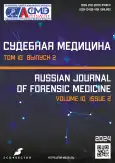合成少数超采样技术提高性别鉴定准确性的潜力: 利用头颅测量学对人工神经网络的研究
- 作者: Handayani V.W.1,2, Yudianto A.1, Sylvia M.3, Riries R.1, Caesarardhi M.R.4, Putra R.1
-
隶属关系:
- Universitas Airlangga
- Pontianak Polytechnic Health Ministry
- Univesitas Airlangga
- Institut Teknologi Sepuluh Nopember
- 期: 卷 10, 编号 2 (2024)
- 页面: 139-151
- 栏目: 原创研究
- URL: https://journals.rcsi.science/2411-8729/article/view/262739
- DOI: https://doi.org/10.17816/fm16110
- ID: 262739
如何引用文章
详细
论证。在使用人工神经网络创建模型时,有必要考虑训练数据的数量及其分布,尤其是在预测性别时。
研究目的是确定合成少数超采样技术(synthetic minority oversampling technique, SMOTE)在使用人工神经网络确定死者性别方面的潜在有效性。
材料和方法。本研究使用的数据集包括对印度尼西亚患者(229 名女性和 68 名男性)进行的297次头颅测量。WebCeph 软件用于测量某些参数,如 SNA 角(Sella-Nation-Point A)、 下颌长度、下颌角、SGA 角(Sella-Glabella-Point A)和诊断。数据处理和人工神经网络的创建使用 Python 编程语言进行。
结果。使用人工神经网络进行性别鉴定的准确率为:女性 87%,男性 0%(平均 78%)。当使用 SMOTE 算法时,性别确定的准确率为 22%(女性为 0%,男性为 37%)。然而,当 SMOTE 算法与数据归一化结合使用时,准确率提高到 71%(女性为 82%,男性为 30%)。在不使用 SMOTE 算法的情况下,使用数据归一化的模型准确率为 76%(女性为 86%,男性为 14%)。
结论。这项研究证明了 SMOTE 在改进男性矩阵分类方面的有效性。然而,与不使用 SMOTE 和数据归一化的结果相比,总体准确度结果还不够理想。为了在使用人工神经网络和其他参数时实现性别确定的最佳精度,需要应用数据平衡策略。
作者简介
Vitria Wuri Handayani
Universitas Airlangga; Pontianak Polytechnic Health Ministry
Email: vitriawuri@gmail.com
ORCID iD: 0000-0002-5076-0118
MD, Medical Faculty; Nursing Department
印度尼西亚, Surabaya; PontianakAhmad Yudianto
Universitas Airlangga
编辑信件的主要联系方式.
Email: ahmad-yudianto@fk.unair.ac.id
ORCID iD: 0000-0003-4754-768X
MD, PhD, Professor, Department of Forensics and Medicolegal, Faculty of Medicine; Magister of Forensic Sciences, Postgraduate School
印度尼西亚, SurabayaMAR Mieke Sylvia
Univesitas Airlangga
Email: mieke-s-m-a-r@fkg.unair.ac.id
ORCID iD: 0000-0001-8821-0157
MD, PhD, Professor, Forensic Odontology Department, Dental Medical Faculty
印度尼西亚, SurabayaRulaningtyas Riries
Universitas Airlangga
Email: riries-r@fst.unair.ac.id
ORCID iD: 0000-0001-7058-1566
MD, Physics Department, Sains and Technology Faculty; Biomedical Department, Sains and Technology Faculty
印度尼西亚, SurabayaMuhammad Rasyad Caesarardhi
Institut Teknologi Sepuluh Nopember
Email: mrasyadc@gmail.com
ORCID iD: 0000-0002-6986-0346
MD, Department of Information Systems
印度尼西亚, SurabayaRamadhan Putra
Universitas Airlangga
Email: ramadhan.hardani@fkg.unair.ac.id
ORCID iD: 0000-0002-0622-3892
MD, Department of Dentomaxillofacial Radiology, Faculty of Dental Medicine
印度尼西亚, Surabaya参考
- Tahir H. Book of abstracts: The 4th Indonesia International Symposium of Forensic Odontology "Incorporating recent advances and new technologies for delivering good evidence in forensic odontology". Amerta Media; 2023. P. 45.
- Subramanian AK, Chen Y, Almalki A, et al. Cephalometric analysis in orthodontics using artificial intelligence: A comprehensive review. Biomed Res Int. 2022;2022:1880113. EDN: VCAUJB doi: 10.1155/2022/1880113
- Ruth MS. Sefalometri radiografi dasar. Surabaya: Sagung Seto; 2013.
- Indra Sukmana B, Rijaldi F. Buku Ajar Kedokteran Gigi Forensik [Internet]. Vol. VI. 2022. P. 1–79. Available from: https://idndentist.com/article/93
- Taner L, Gursoy G, Uzuner F. Does gender have an effect on craniofacial measurements? Turkish J Orthod. 2019;32(2):59–64. doi: 10.5152/TurkJOrthod.2019.18031
- Patil V, Vineetha R, Vatsa S, et al. Artificial neural network for gender determination using mandibular morphometric parameters: A comparative retrospective study. Cogent Eng. 2020;7(1):1–12. doi: 10.1080/23311916.2020.1723783
- Chen M, Chalita U, Saad W, et al. Artificial neural networks-based machine learning for wireless networks: A tutorial. IEEE Commun Surv Tutorials. 2019;21(4):3039–3071. doi: 10.1109/COMST.2019.2926625
- Dastres R, Soori M. Artificial neural network systems. Int J Imaging Robot. 2021;2021(2):13–25.
- Da Silva IN, Hernane SD, Andrade FR, et al. Artificial neural networks: A practical course. Springer Nature: Switzerland; 2017. 252 р.
- Wu Y, Feng J. Development and application of artificial neural network. Wirel Pers Commun. 2018;102(5):1645–1656. doi: 10.1007/s11277-017-5224-x
- Elreedy D, Atiya AF, Kamalov F. A theoretical distribution analysis of synthetic minority oversampling technique (SMOTE) for imbalanced learning. Mach Learn. 2023;113(7):4903–4923. EDN: KFIOLR doi: 10.1007/s10994-022-06296-4
- Handayani V, Yudianto A, Mieke Sylvia MAR, Rulaningtyas R. Classification of Indonesian adult forensic gender using cephalometric radiography with VGG16 and VGG19: A preliminary research. Acta Odontol Scand. 2024;(83):308–316. doi: 10.2340/aos.v83.40476
- Handayani VW. Cephalometry radiology based on rrtificial intelligence model for predict gender determination in unidentified cranium. Universitas Airlangga; 2024.
- Hapsari RK, Miswanto M, Rulaningtyas R, et al. Modified gray-level haralick texture features for early detection of diabetes mellitus and high cholesterol with iris image. Int J Biomed Imaging. 2022;2022:5336373. EDN: BVEODY doi: 10.1155/2022/5336373
- Satish BN, Moolrajani C, Basnaker M, Kumar P. Dental sex dimorphism: Using odontometrics and digital jaw radiography. J Forensic Dent Sci. 2017;9(1):43. doi: 10.4103/jfo.jfds_78_15
- Arab MA, Khankeh HR, Mosadeghrad AM, Farrokhi M. Developing a hospital disaster risk management evaluation model. Risk Manag Healthc Policy. 2019;(12):287–296. doi: 10.2147/RMHP.S215444
- Vahanwala S. Assessment of the effect of dimensions of the mandibular ramus and mental foramen on age and gender using digital panoramic radiographs: A retrospective study. Contemp Clin Dent. 2019;9(3):343–348. doi: 10.4103/ccd.ccd_26_18
- Tahir H. Book of abstracts: The 4th Indonesia International Symposium of Forensic Odontology "Incorporating recent advances and new technologies for delivering good evidence in forensic odontology". Amerta Media; 2023. P. 36–37.
- Bao H, Zhang K, Yu C, et al. Evaluating the accuracy of automated cephalometric analysis based on artificial intelligence. BMC Oral Health. 2023;23(1):191. doi: 10.1186/s12903-023-02881-8
- Ramezanzade S, Laurentiu T, Bakhshandah A, et al. The efficiency of artificial intelligence methods for finding radiographic features in different endodontic treatments: A systematic review. Acta Odontol Scand. 2022;81(6):422–435. doi: 10.1080/00016357.2022.2158929
- Shung KP. Accuracy, precision, recall or F1? [Internet]. Towards Data Science. 2018 [cited 2023 Sep 2]. Available from: https://towardsdatascience.com/accuracy-precision-recall-or-f1-331fb37c5cb9. Accessed: 15.04.2024.
- Jeong SH, Yun JP, Yeom HG, et al. Deep learning based discrimination of soft tissue profiles requiring orthognathic surgery by facial photographs. Sci Rep. 2020;10(1):16235. doi: 10.1038/s41598-020-73287-7
- Elreedy D, Atiya AF. A comprehensive analysis of Synthetic Minority Oversampling Technique (SMOTE) for handling class imbalance. Inf Sci (Ny). 2019;(505):32–64. doi: 10.1016/j.ins.2019.07.070
- Duan F, Zhang S, Yan Y, Cai Z. An oversampling method of unbalanced data for mechanical fault diagnosis based on meanradius-SMOTE. Sensors. 2022;22(14):5166. EDN: PURYZO doi: 10.3390/s22145166
- Zhang K, Zhang Y, Wang M. A unified approach to interpreting model predictions scott. Nips. 2012;16(3):426–430. doi: 10.48550/arXiv.1705.07874
- Sikka A, Jain A. Sex determination of mandible: A morphological and morphometric analysis. Int J Contemp Med Res. 2016;3(7):1869–1872.
- Smart Energy and Electric Power Systems [Internet]. Pavithra V, Jayalakshmi V. Smart energy and electric power system: Current trends and new intelligent perspectives and introduction to ai and power system. Elsevier; 2023. Р. 19–36. doi: 10.1016/B978-0-323-91664-6.00001-2
- Fan DP, Zhang J, Xu G, et al. Salient objects in clutter. IEEE Trans Pattern Anal Mach Intell. 2023;45(2):2344–2366. doi: 10.1109/TPAMI.2022.3166451
补充文件











